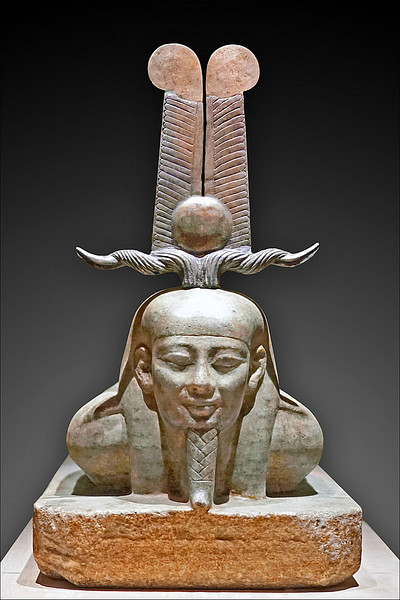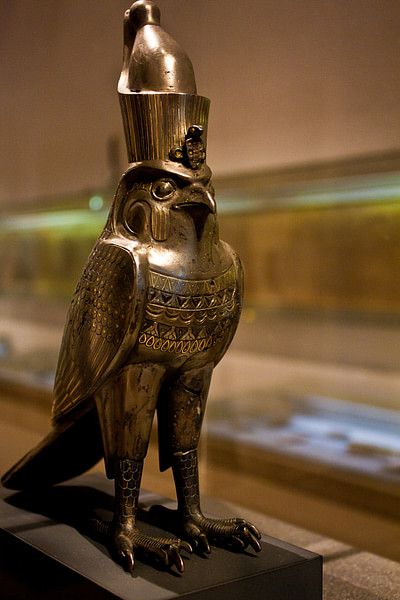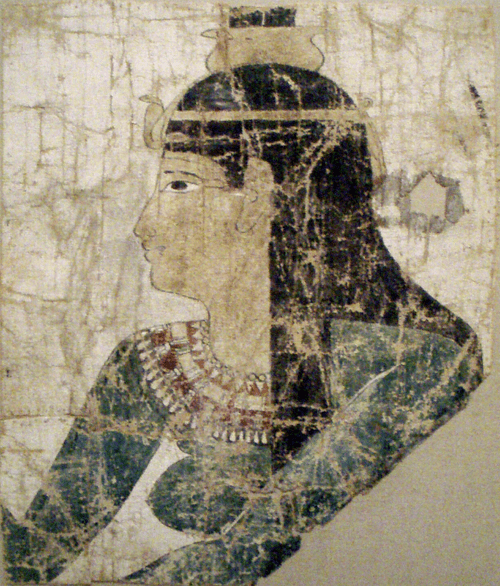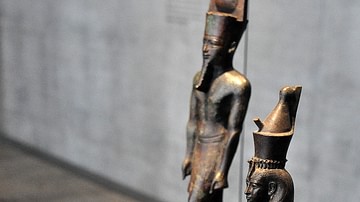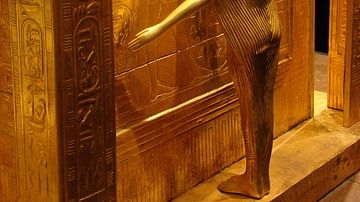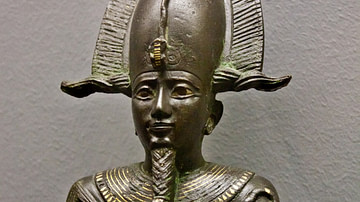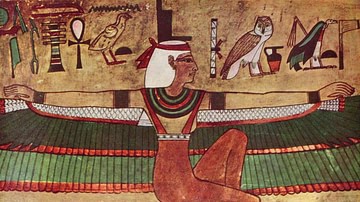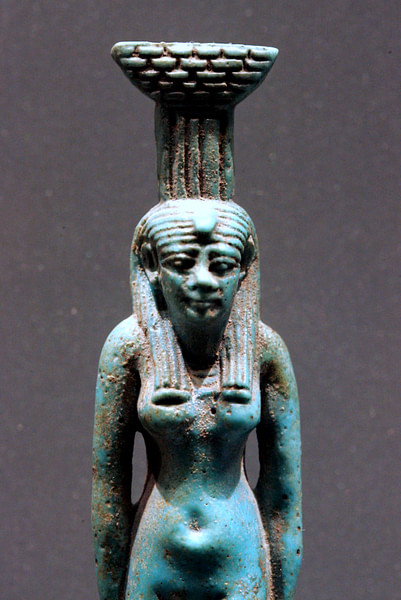
Nephthys was one of the original five gods of ancient Egypt born of the union of Geb (earth) and Nut (sky) after the creation of the world. She was the fourth born after Osiris, Isis, and Set and was the older sister of Horus (usually referred to as Horus the Elder).
As one of the earliest goddesses of Egypt, she was a member of the Ennead of Heliopolis, a tribunal of nine deities of immense power. Her cult centers were Heliopolis, Senu, Hebet, Per-met, Re-nefert, and Het-sekem. Contrary to some scholars' assertions that she was never widely worshipped in Egypt, temples to Nephthys were quite common and she was considered an extremely important goddess from the Predynastic Period (c.6000-c. 3150 BCE) through the Ptolemaic Dynasty (323-30 BCE), the last dynasty to rule Egypt before it became a province of Rome.
Name & Symbols
'Nephthys' is the Latin version of her Egyptian name `Nebthwt' (also given as Nebet-het and Nebt-het) which translates as "Lady of the Temple Enclosure" or "Mistress of the House" and she is routinely pictured with the heiroglyph for 'house' on her crown. The 'house' is neither an earthly home nor temple but linked to the heavens as she was related to air and ether. The 'enclosure' may refer to the courtyard outside a temple as she was represented by the pylons outside of temples in her role as a protective goddess; just as the pylons and wall protected the inner temple, Nephthys protected the souls of the people.
She was associated with death and decay from an early period and was regularly invoked during funeral services. Professional mourners at Egyptian funerals were known as "Hawks of Nephthys" and she is one of the four goddesses (along with Isis, Selket, and Neith) whose images were found in the tomb of Tutankhamun as guardians of his canopic vessels. Historian Margaret Bunson notes:
Nephthys was associated with the mortuary cult in every era and was part of the ancient worship of Min [a god of fertility and reproduction]. The desert regions were dedicated to her and she was thought to be skilled in magic. (188)
Her magical skills were similar to those of Isis and some scholars see her as Isis' mirror image, Nephthys' darkness balancing Isis' light, and they are frequently pictured together as twin sisters. In the city of Heliopolis Nephthys and Isis were represented by two virgin priestesses at festivals who would recite the famous Lamentations of Isis and Nepthys at the Osiris' festival. The Lamentations is a long narrative poem recreating the moment Isis and Nephthys worked together to revive the god Osiris and bring him back to life. Although originally spoken only at religious services, the Lamentations came to be included in the Egyptian Book of the Dead and was recited at funeral services.
Nephthys became the wife of Set and is best known for the part she played in the Osiris myth where, disguised as Isis, she seduced Osiris and provided Set with justification for the murder of his brother. She is later depicted in the myth as both betraying and then helping Isis in her efforts to restore her husband to life.
She is a goddess of the dead who, like her granddaughter Qebhet, provides assistance to the souls of the deceased. She was so helpful to those in the afterlife that one of her titles was "Friend of the Dead" and she was also thought to bring news of the deceased back to their relatives on earth and comfort them in their time of mourning.
Her symbols are the hawk and the temple and the sycamore tree, one of the more popular trees depicted in inscriptions from the Egyptian Book of the Dead. She is the mother of the death god Anubis and was associated with the setting sun, twilight, and darkness. Prayers were offered to Nephthys at twilight for protection and also to aid her as she struggled with her husband Set to defend the Boat of Ra (the sun god) from the serprent Apophis as it made its journey through the realms of night.
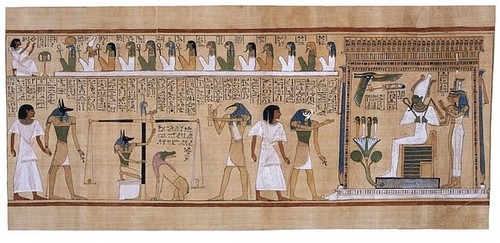
Mythological Origins
According to the most popular version of the Egyptian creation myth, there was once only swirling chaotic waters and darkness in the universe until, one day, a mound (known as the ben-ben) rose from the seas with the god Atum (also given as Ra in some myths) standing upon it. Atum gazed out on the eternal nothingness and recognized he was lonely, and so mated with his own shadow to give birth to Shu (god of the air) and Tefnut (goddess of moisture). These two deities then left their father alone on the primordial mound and went off to create the world.
Atum, alone on the hill in the midst of chaos, longed for his children and worried over their safety, and so he removed his eye and sent it out in search of them. Shu and Tefnut returned with the eye, having failed to create the world, and Atum was so happy to see them, he began to cry. As his tears fell on the fertile earth of the ben-ben, men and women sprang up.
These new fragile beings had nowhere to live, however, and so Shu and Tefnut mated and gave birth to Geb (the earth) and Nut (the sky). These two quickly fell in love and became inseparable; a situation Atum found intolerable as they were brother and sister. He pushed Nut high above Geb and fastened her there so the two lovers would be able to see each other but never touch again. Nut, however, was already pregnant by Geb and soon gave birth to five children: Osiris, Isis, Set, Nephthys, and Horus. Atum gave to these five gods the task of maintaining the world and set his first born, Osiris, to rule over all the living things of the earth.
The Osiris Myth
At this point in the story the famous Osiris Myth begins when Set becomes jealous of Osiris' power and success. Osiris married his beautiful sister Isis and the royal couple taught the humans of the world culture and art, instructed them in religion, and gave them the gifts of agriculture. To the Egyptians, their country was essentially the world and this world, under the reign of Osiris and Isis, was a paradise. Men and women were equal in all things and there was an abundance of food.
Horus the Elder, in this story, is never mentioned but the roles of Set and Nephthys, who are, seem fairly insignificant at first until Nephthys emerges to play a pivotal role. She changed her form to take on the shape and scent of Isis and seduced Osiris, who thought he was sleeping with his wife. In some versions of the story she drugs his wine or gives him too much while, in others, he simply comes to her bed thinking she is Isis. Osiris leaves afterwards but drops a flower he wore in his hair on the floor and this is later found by Set who recognizes it as his brother's.
Set was already resentful of his older brother but now, believing Osiris had seduced his wife, he planned to murder him. He created an ornate chest to Osiris' exact measurements and then threw a party where he offered the box as a gift to whichever of his guests could best fit in it. Osiris, of course, fit perfectly and, when he lay down in the casket, Set slammed the cover on, fastened it, and threw it into the Nile. He then assumed the throne with Nephthys as his consort. She gave birth a short time later to a son, the god Anubis, whom she abandoned and who was raised by Isis.
Isis, meanwhile, went in search of her husband and found the casket with his body inside lodged in a tree in Byblos. The king and queen of the city had seen the tree down by the shore and were attracted by its beauty (which was the essence of Osiris permeating the tree) and its sweet scent (the aroma of Osiris) and had it cut down and brought to their court to serve as a central pillar. Isis, disguised as an older woman, was invited to the court after she befriended the queen's handmaidens down by the shore and soon became nursemaid to the young princes. In an effort to make the youngest son immortal, she held him in a mystical fire each night to burn away his mortal part and, one night, the queen caught her and was horrified. Isis threw off her disguise, revealing herself, and the king and queen begged her for mercy, offering her anything to spare them. She asked for the pillar in the court; and they gave it to her.
All this time, the world was suffering under the rule of Set. The land was barren and the desert winds blew. Equality in the land was forgotten as people fought for each other for survival. Isis returned to the wasteland with Osiris and hid his body in the marshes of the Nile Delta and then asked Nephthys to stand guard to protect him from Set.
While Isis went off to find herbs to revive her husband, Set was out searching for the body and found Nephthys. He managed to get from her where Isis had hidden Osiris and hacked the body to pieces, throwing them across the land and into the river. When Isis returned, Nephthys tearfully told her the story and offered to help in any way she could.
Isis and Nephthys found all the parts of Osiris and put him back together except for his penis, which had been eaten by a fish. Osiris revived but, because he was not whole, could not return to the land as king; he would instead descend to the underworld where he would rule over the dead as their just and merciful judge. Before he left, however, Isis transformed herself into a kite (a falcon) and flew around his body, drawing his seed into her own and becoming pregnant with a son, Horus. When Horus was born, she hid him in the marshes of the Delta as she had his father's body and Nephthys, this time, kept her secret.
The Contendings of Horus & Set
When Horus grew to manhood he challenged Set for the kingdom. The best known version of this contest is known as The Contendings of Horus and Set from a manuscript of the Twentieth Dynasty (1190-1077 BCE). The story tells of the legal battle before the Ennead of Heliopolis, a tribunal of nine gods, to decide who was the rightful king of Egypt. These gods were Atum, Shu and Tefnut, Geb and Nut, Isis and Nephthys, Set, and Osiris. Horus and Set both present their cases and then must prove themselves in a series of contests and battles which are all won by Horus.
The majority of the nine gods ruled that Horus was the rightful king but Atum, the sun god, was not convinced and the decision had to be unanimous, barring Set's opinion. Atum believed that Horus was too young and had led too sheltered a life to effectively rule while Set had the necessary experience if not the most gentle manner. Even though Horus won every contest against his uncle, Atum would not be moved. This trial went on for over 80 years while the people of Egypt suffered under Set's chaotic reign until Isis intervened, showed the other gods - and Set - how wickedly he had behaved, and won the ruling in favor of her son.
In another, perhaps older, version of the story it is the goddess Neith who settles the dispute in favor of Horus and grants the desert lands to Set along with two foreign goddesses (Anat and Astarte) as consolation. Horus assumed the throne of his father and ruled with Isis and Nephthys as his counselors. Set was driven from the land to the arid frontier deserts and Nephthys remained as a protector of the female head of the household, Isis in this case, but later any mature married woman.
The Lamentations of Isis & Nephthys
This myth was important to the ancient Egyptians on many levels. It illustrated core values of harmony, order, divine intervention in human affairs, the importance of gratitude, trust, and how, in the character of Set, even the gods could succumb to temptation but, no matter what, harmony and order would be restored. The death and ressurection of Osiris provided a divine template for the passage of all human beings who were thought to be travelers on an eternal journey through life and on into the afterlife. The Cult of Osiris became extremely popular and part of his religious service included the recitation of the liturgy known as The Lamentations of Isis and Nephthys.
The most complete version of this verse comes from the Berlin Papyrus 3008 dating to the Ptolemaic Dynasty. This papyrus was part of a copy of The Book of the Dead owned by a woman named Tentruty (also given as Teret) and is written in hieratic script (the cursive, everyday, script of the Egyptians) in five columns. The poem is written as an exchange between Isis and Nephthys as they call Osiris' soul back to his body. The two goddesses entreat the soul to return, to live again among them, and invoke Horus, Osiris' son, as his protector in life who will provide him with "bread, beer, oxen, and fowl" and whose sons will guard his body and protect his soul. In the end, Osiris returns to life as the poem ends with the line, "Lo! He Comes!"
Following the verse, the scribe has left very careful instructions on how the Lamentations is to be presented at the festivals:
Now, when this is recited the place is to be completely secluded, not seen and not heard by anyone except the chief lector-priest and the setem-priest. One shall bring two women with beautiful bodies. They shall be made to sit on the ground at the main portal of the Hall of Appearings. On their arms shall be written the names of Isis and Nephthys. Jars of faience filled with water shall be placed in their right hands, offering loaves made in Memphis in their left hands, and their faces shall be bowed. To be done in the third hour of the day, also in the eighth hour of the day. You shall not be slack in reciting this book in the hour of the festival. It is finished.
The two virgins would recite the Lamentations to invite Osiris to participate in the festival and, once he arrived, the celebration could begin. Osiris was considered the first king of Egypt who had given the people their culture and who, through his death and resurrection, showed them the way to eternal life. In death, everyone was linked to Osiris who was the first to have died and been reborn. His festivals, therefore, were of great importance and Nephthys regularly featured as one of the most important elements of the celebration: one of the two who called the god to join the living.
She describes herself as the "beloved sister" of Osiris in the Lamentations and says, "I am with you, your bodyguard, for all eternity." When the Lamentations became included in The Book of the Dead (c. 1550-1070 BCE), the poem was recited at funerals and Nephthys would then have been speaking to the soul of the deceased. It was in this capacity that she came to be regarded as the "Friend of the Dead" who walked with the soul and helped them in the afterlife as their "bodyguard for all eternity" and made her such an important deity to the people.
Nephthys & The Barge of Ra
Long before the Osiris myth became popular, Nepthys was already a very significant goddess, however. In texts of the period of the Old Kingdom (c. 2613 - c. 2181 BCE) she is referenced with Set as the two gods who protect the barge of the sun god Ra (Atum) as it passes through the night sky.
The evil serpent Apophis tried every night to murder the sun god but Nephthys and Set fought the creature off so the sun could rise the next morning. Set was later transformed from a protector god to the villain of the Osiris myth but Nephthys' role remained the same: a protector and sustainer of life. Even though the focus on who was protected changed, the basic elements of her character remained the same. The scholar Geraldine Pinch has observed that, "Nephthys never enjoyed the high status of her sister, Isis" (171) and, while it may be true that worship of Nephthys never was on par with that of Isis, her status was consistently quite impressive throughout Egypt's history.
In the Predynastic Period of Egypt, Nephthys was one of the most important deities owing to her part in this myth. If Apophis succeeded in murdering Ra, the sun would not rise and so it was vital that the barge be protected. In the Coffin Texts Set and the snake-god Mehen protect the barge; Mehen by coiling himself around Ra and Set by fending off Apophis. Mehen was later replaced by Nephthys but Apophis was considered so powerful, and the threat to Ra so dire, that other deities often appear on the barge to drive the enemy of the sun away such as Isis, Bastet, Selket, Neith, and Sekhmet who were collectively known, with Nephthys, as the Eyes of Ra in this capacity.
The myth of the nightly threat to Ra is most clearly told in a manuscript dating from the Ramessid Period (1292-1069 BCE) but archaeological evidence suggests the story is much older. By the time of the Ramessid Period the myth had evolved into a ritual known as Overthrowing Apophis in which a priest would recite a list of Apophis' secret names (thereby gaining power over him) and the people would sing hymns celebrating his destruction.
Even though the gods destroyed the great serpent every night, he returned to try to murder Ra again the next. The hymns were sung to encourage the gods in their eternal struggle. Participants in the ritual would then make serpents out of wax, spit on them, and destroy them in fire. The ritual was performed regularly after a number of cloudy days when it seemed as though Apophis was succeeding in preventing the dawn and especially during a solar eclipse.
Popularity & Worship of Nephthys
Prior to the addition of the other goddesses, however, it was Nephthys and Set who kept the sun on course and she was duly honored for this. Temples to Nephthys were located in every region of Egypt long before she became associated with the dead and only grew more numerous afterwards. As with any Egyptian deity, her temple was attended by priests and priestesses who cared for her statue and observed her holy days and festivals. The public was barred from entering the inner sanctuary of the temple where her statue resided but were welcomed in the outer courtyards where the clergy tended to their needs and collected their donations and sacrifices.
By the time of Ramesses II (r. 1279 - 1213 BCE) Nephthys was so popular she was given her own temple at the popular religious center of Sepermeru in the holy precinct where Set's temple was located. Nephthys was so popular at this time that she is mentioned in texts without allusion to Isis or Set. Her temple in the town of Punodjem was apparently so popular that the head priest and vizier Pra'emhab complained of his workload and her temple at Herakleopolis, near Sepermeru, became the site of the Heb-Sed festival celebrating the rejuvenation of the king. The basalt statue of Nephthys currently housed at the Louvre in Paris comes from this temple.
Although Nephthys is frequently depicted as a mirror to her twin sister Isis, she had a life and status all her own which was just as worthy of veneration. Once she became associated with the afterlife and the care of the dead the linen which was used to mummify the deceased was known as "tresses of Nephthys" and it was thought that she, along with Selket, helped to breathe life back into the soul and help them on their eternal journey.
Nephthys came to represent the promise of a helper at one's side in the afterlife who would look after and protect the soul and who assured the living that death was nothing to be feared. The realm of the afterlife was only a new land one traveled to and old friends, like Nephthys, would be waiting to offer their protection and guidance in death as they had throughout life.
